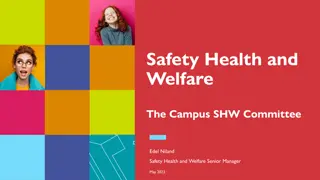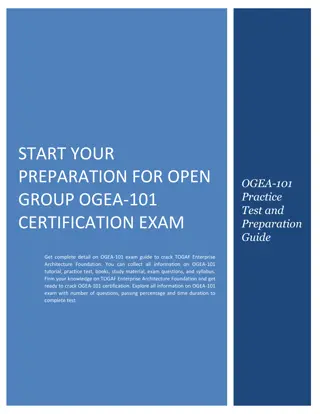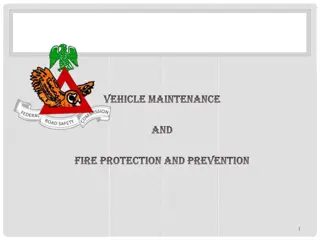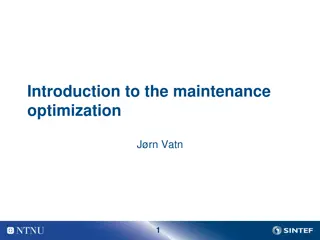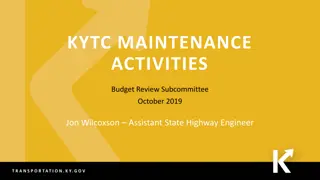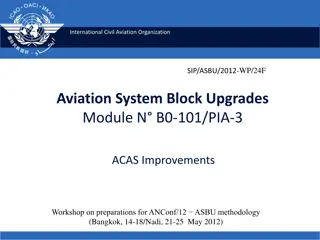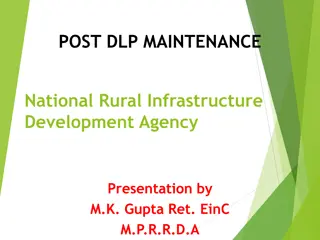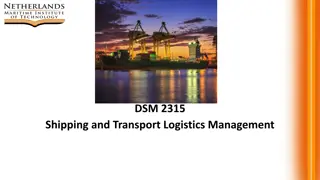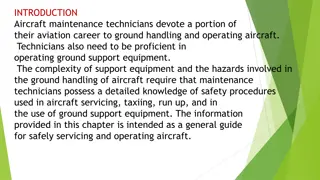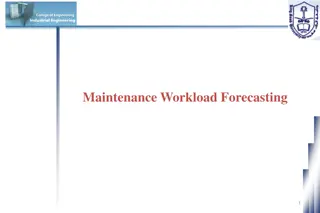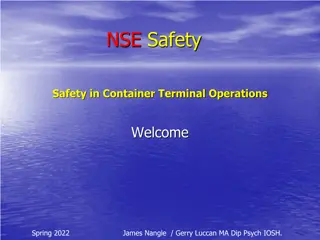
Safety Director 101: Role of Safety in Maintenance Procedures
Explore the essential overlap between safety practices and maintenance tasks in the transportation industry through topics such as regulations, inspector qualifications, and brake maintenance standards. Understand the critical role safety directors play in ensuring compliance and vehicle integrity.
Download Presentation

Please find below an Image/Link to download the presentation.
The content on the website is provided AS IS for your information and personal use only. It may not be sold, licensed, or shared on other websites without obtaining consent from the author. If you encounter any issues during the download, it is possible that the publisher has removed the file from their server.
You are allowed to download the files provided on this website for personal or commercial use, subject to the condition that they are used lawfully. All files are the property of their respective owners.
The content on the website is provided AS IS for your information and personal use only. It may not be sold, licensed, or shared on other websites without obtaining consent from the author.
E N D
Presentation Transcript
SAFETY DIRECTOR 101 THE ROLE OF SAFETY IN MAINTENANCE What does safety and maintenance have in common ? Where do our roles and responsibilities overlap ? 49CFR and 29CFR
SAFETY DIRECTOR 101 THE ROLE OF SAFETY IN MAINTENANCE 49CFR FMCSA Regulations Mechanic Certifications Annual Inspections and Brake Certification DVIRs Work Orders PM Inspections Deferred maintenance 90 Safety checks for windows and escape hatches Roadside Inspection Documentation Maintenance Records relating to DOT Reportable Crashes ADA equipment Intermediary between maintenance and operations
SAFETY DIRECTOR 101 THE ROLE OF SAFETY IN MAINTENANCE INSPECTOR QUALIFICATIONS Certification 49 CFR Part 396.19 Motor carriers are responsible for ensuring that individual(s) performing an annual inspection under 396.19 are qualified as follows: Understands the inspection criteria set forth in Part 393 and Appendix G and can identify defective components Is knowledgeable of and has mastered the methods, procedures, tools and equipment used when performing an inspection ls capable of performing an inspection by reason of experience, training, or both, and qualifies in one of the following categories (check all that apply): I. Successfully completed a State or Federal training program or has certificate from a State or Canadian Province which qualifies the person to perform commercial vehicle safety inspections. Specify: or II. Have a combination of training or experience totaling at least one year as follows (check all that apply): A. Participation in a truck manufacturer-sponsored training program or similar commercial training program designed to train students in truck operation and maintenance. Where and Date: B. ______ (years) experience as a mechanic or inspector in a motor carrier maintenance program. Name and Date: C. ______ (years) experience as a mechanic or inspector in truck maintenance at a commercial garage, fleet leasing company, or similar facility. Name of Facility and Dates: D. ______ (years) experience as a commercial vehicle inspector for a State, Provincial, or Federal Government. Where and Dates: I certify the above information is true and accurate to the best of my knowledge. Employee ________________________________________ _______________ Motor Carrier/Company _________________________________ _______________ Evidence of Inspector Qualifications are on file at:
SAFETY DIRECTOR 101 THE ROLE OF SAFETY IN MAINTENANCE BRAKE INSPECTOR QUALIFICATIONS Certification 49 CFR Part 396.25 Brake Inspector means any employee of a motor carrier who is responsible for ensuring all brake inspections, maintenance, service, or repairs to any commercial motor vehicle, subject to the motor carrier s control, meet the applicable Standards. No motor carrier shall require or permit any employee who does not meet minimum brake inspector qualifications to be responsible for the inspection, maintenance, service or repairs of any brakes on its commercial motor vehicles. Minimum Qualifications Understands and can perform brake service and inspection Is knowledgeable of and has mastered the methods, procedures, tools and equipment necessary to perform brake service and inspection Is capable of performing brake service or inspection by reason of experience, training, or both, and qualifies in one of the following categories (check all that apply): I. Has successfully completed an apprenticeship program sponsored or approved by a State, Canadian Province, a Federal agency or labor union, or has a certificate from a State or Canadian Province which qualifies the person to perform brake service or inspections. Specify: II. Has brake-related training or experience or a combination thereof totaling at least one year as follows (check all that apply): A. Participation in a brake maintenance or inspection training program sponsored by a brake or vehicle manufacturer or similar commercial training program. Where and Date: B. ______ (years) experience performing brake maintenance or inspection in a motor carrier maintenance program. Name and Date: C. ______ (years) experience performing brake maintenance or inspection at a commercial garage, fleet leasing company, or similar facility. Name of Facility and Dates: I certify the above information is true and accurate to the best of my knowledge.
SAFETY DIRECTOR 101 THE ROLE OF SAFETY IN MAINTENANCE BRAKE INSPECTOR QUALIFICATIONS Certification 49 CFR Part 396.25 I certify the above information is true and accurate to the best of my knowledge. Employee __________________________________________ ______________ Motor Carrier/Company __________________________________ _____________ Evidence of Inspector Qualifications are on file at: _____________________________________________________________________________ What about techs at other shops ? Who is responsible for the recordkeeping ?
SAFETY DIRECTOR 101 THE ROLE OF SAFETY IN MAINTENANCE DVIR Defect only or daily reports defects or not Paper or plastic ? Record retention 90 days ? 6 months ? Do you retain DVIRs with work orders Reviewed for completeness? Reviewed for repeat defects ?
SAFETY DIRECTOR 101 THE ROLE OF SAFETY IN MAINTENANCE Work orders Why is safety concerned with work orders? If it s not in writing it never happened Inspections, repairs, campaigns
SAFETY DIRECTOR 101 THE ROLE OF SAFETY IN MAINTENANCE PM program How is it structured? Time , miles, hours combinations What are the requirements? Federal, state may be more strict, manufacturer recommendations How many inspections do you have? Can they be made more efficient?
SAFETY DIRECTOR 101 THE ROLE OF SAFETY IN MAINTENANCE Deferred maintenance Definition ? How do you monitor it ? How do you measure it? Who sets your maintenance schedules? Who holds maintenance responsible?
SAFETY DIRECTOR 101 THE ROLE OF SAFETY IN MAINTENANCE 90 day window checks and escape exits How are these monitored? Make sure you cover all of the requirements Markings, handles accessible, hatches open and close properly Kids love to peel off the stickers on the windows as well as the seat backs Great time to check seat belts and other safety equipment as well
SAFETY DIRECTOR 101 THE ROLE OF SAFETY IN MAINTENANCE Roadside inspection documentation Make sure they are all accounted for and returned to the reporting agency within 15 days Some states are fining companies by the day for late returned reports Make sure you have repair documentation for all defects Review defects and especially OOS reports DataQ any reports that you feel and can substantiate are incorrect All of these inspections good and bad impact your safety rating
SAFETY DIRECTOR 101 THE ROLE OF SAFETY IN MAINTENANCE Maintenance records for DOT reportable crashes What is a recordable crash ? Make sure everything from the tow bill to any inspections and repairs are documented and carefully filed with the accident file Make sure everyone that does any inspection or repairs are qualified Review maintenance records prior to crash as well
SAFETY DIRECTOR 101 THE ROLE OF SAFETY IN MAINTENANCE ADA equipment Check buses not only for lift operation but also the ability to move seats Also check and record inspection of tie down equipment for all types of mobility devices Set up a program with the maintenance shop to regularly run and test ADA lifts
SAFETY DIRECTOR 101 THE ROLE OF SAFETY IN MAINTENANCE Intermediary between maintenance and operations Develop a positive relationship with your shop and operations Review policies in how many vehicles per day can be removed for maintenance Work together to make a schedule to do maintenance prior to the busier seasons Consider away trip inspections prior to multiday trips
SAFETY DIRECTOR 101 THE ROLE OF SAFETY IN MAINTENANCE What are your responsibilities for safety in the shop 29 CFR OSHA regulations Also check with your state to see if they have additional regulations Forklifts Storage and record keeping of HAZWOPER documents Storage of hazmats Monthly inspections Pit and lift safety
SAFETY DIRECTOR 101 THE ROLE OF SAFETY IN MAINTENANCE What are your responsibilities for safety in the shop Safety covers every part of our operations Become familiar with the OSHA laws Managing by walking around Look, talk, engage Know what you are looking at Ask questions and listen Don t be afraid to spend time in the shop
SAFETY DIRECTOR 101 THE ROLE OF SAFETY IN MAINTENANCE 29 CFR OSHA regulations This the occupational safety code similar to the FMCSRs Make sure you look at the non-construction aspects of the code Simple items can costs lives and heavy penalty Rule of 7s Fire extinguishers, exit signs, PPE Also check with your state to see if they have additional regulations Many offer free classes to help you learn this aspect of safety
SAFETY DIRECTOR 101 THE ROLE OF SAFETY IN MAINTENANCE Forklifts Do you have one? Is everyone trained to use it? Are you doing daily inspections? Are you performing or have contracted maintenance on it? When is training required ?
SAFETY DIRECTOR 101 THE ROLE OF SAFETY IN MAINTENANCE Storage and record keeping of HAZWOPER documents MDS material data sheets Explain all of the hazards associated with the item Explains exposure hazards and how to handle releases Work with local fire departments for hazmat awareness Make sure your employees are trained on where they are and how to read them
SAFETY DIRECTOR 101 THE ROLE OF SAFETY IN MAINTENANCE Storage of hazmats Know what the regulations are Know where they are Know what and what not can be stored in close proximity Know what kind of vessel they can be stored in Many techs use old soda bottles ,etc to store simple chemicals for ease of use Know what to do in case of a release
SAFETY DIRECTOR 101 THE ROLE OF SAFETY IN MAINTENANCE Monthly inspections Part of managing by walking around Form a committee of different departments Look at all aspects Fire extinguishers, exit signs, PPE, guards on machines, lock out tag out Document the inspections Have a suggestion method for employees to report safety items or ideas to improve safety
SAFETY DIRECTOR 101 THE ROLE OF SAFETY IN MAINTENANCE Pit and Lift Safety Pits Make sure they have protection barriers poles, lines , nets Make sure they are clean Check entrances and exits Make sure anyone driving over a pit has a spotter Make sure guide lines and all critical areas are painted and kept clean
SAFETY DIRECTOR 101 THE ROLE OF SAFETY IN MAINTENANCE Pit and Lift Safety Lifts Receive training from the lift manufacturer Make sure all new employees are trained on the equipment
Mike McDonal mmcdonal@saucontech.com 410-245-5525


